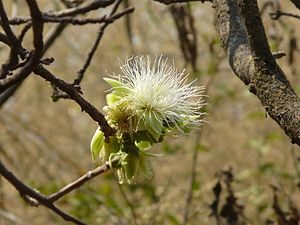Note: This is a project under development. The articles on this wiki are just being initiated and broadly incomplete. You can Help creating new pages.
Careya arborea - Kubhīkaḥ
Kulaµjana consists of dried rhizome of Alpinia galanga. It is a plant grows up to about 2m tall. It is native to eastern Himalayas and southwest India. This plat is belongs to Lecythidaceae family.
Contents
- 1 Uses
- 2 Parts Used
- 3 Chemical Composition
- 4 Common names
- 5 Properties
- 6 Habit
- 7 Identification
- 8 List of Ayurvedic medicine in which the herb is used
- 9 Where to get the saplings
- 10 Mode of Propagation
- 11 How to plant/cultivate
- 12 Commonly seen growing in areas
- 13 Photo Gallery
- 14 References
- 15 External Links
Uses
Parts Used
Chemical Composition
Seeds contain triterpenoid sapogenols, sterols; leaves contain a triterpene ester, beta-amyrin, hexacosanol, taraxerol, beta-sitosterol, quercetin and taraxeryl acetate.[1]
Common names
| Language | Common name |
|---|---|
| Kannada | Daddala, Gudda, Daddippe |
| Hindi | Kumbhi |
| Malayalam | Pezuntol |
| Tamil | Ayma |
| Telugu | Gadava |
| Marathi | NA |
| Gujarathi | NA |
| Punjabi | NA |
| Kashmiri | NA |
| Sanskrit | Svādupuṣpa, Viṭapī, Sthala Kumbhī |
| English | Cyloneoek |
Properties
Reference: Dravya - Substance, Rasa - Taste, Guna - Qualities, Veerya - Potency, Vipaka - Post-digesion effect, Karma - Pharmacological activity, Prabhava - Therepeutics.
Dravya
Rasa
Kaṭu, Kaṣāya
Guna
Rūkṣa
Veerya
Uṣṇa
Vipaka
Kaṭu
Karma
Kaphahara, Vātahara, Grāhī,
Prabhava
Habit
Identification
Leaf
| Kind | Shape | Feature |
|---|---|---|
| Paripinnate | Oblong | Leaf Arrangement is Alternate-spiral |
Flower
| Type | Size | Color and composition | Stamen | More information |
|---|---|---|---|---|
| Unisexual | 2-4cm long | Pink | Flowering throughout the year and In terminal and/or axillary pseudoracemes |
Fruit
| Type | Size | Mass | Appearance | Seeds | More information |
|---|---|---|---|---|---|
| Oblong pod | Thinly septate, pilose, wrinkled | Seeds upto 5 | Fruiting throughout the year |
Other features
List of Ayurvedic medicine in which the herb is used
Where to get the saplings
Mode of Propagation
How to plant/cultivate
Fresh seeds germinate readily. Prefers a well-drained, sandy or even rocky soil.[5]
Commonly seen growing in areas
Secondary forest, Slightly seasonal forest, Along forest edges.
Photo Gallery
References
- ↑ Chemical composition
- ↑ Cite error: Invalid
<ref>tag; no text was provided for refs namedCommon names - ↑ [Morphology]
- ↑ Ayurvedic preparations
- ↑ Cultivation details
External Links
- Pages with reference errors
- Ayurvedic Herbs known to be helpful to treat Body swellings
- Ayurvedic Herbs known to be helpful to treat Cough
- Ayurvedic Herbs known to be helpful to treat Cold
- Herbs with Fruits used in medicine
- Herbs with Seeds used in medicine
- Herbs with common name in Kannada
- Herbs with common name in Hindi
- Herbs with common name in Malayalam
- Herbs with common name in Tamil
- Herbs with common name in Telugu
- Herbs with common name in Sanskrit
- Herbs with common name in English
- Habit - Deciduous tree
- Index of Plants which can be propagated by Seeds
- Herbs that are commonly seen in the region of Secondary forest
- Herbs that are commonly seen in the region of Slightly seasonal forest
- Herbs that are commonly seen in the region of Along forest edges
- Herbs
- Ayurvedic herbs that don't have seed photos
- Lecythidaceae






